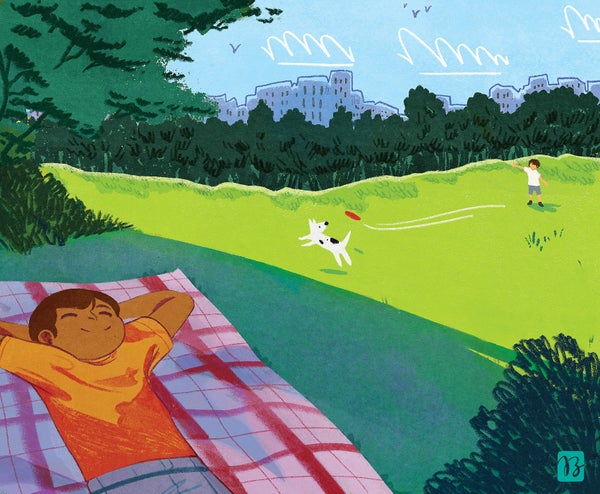Like so many people, I took refuge in the outdoors during the worst of the COVID pandemic, going on socially distanced walks and sitting on the deck in all kinds of weather. Being outside reduced the chance of infection, but it also helped in other ways. “I think everybody got that nature seemed to be the solution for a lot of the stress issues that people were dealing with,” says Jay Maddock, an experimental psychologist and director of the Center for Health & Nature at Texas A&M University. Scientists got it, too. Research into the health benefits of nature has “exploded” since then, Maddock says.
More time in the green is associated with lower blood pressure, strengthened immune systems, lower risk of cardiovascular disease and improved sleep. A recent study found it might slow the shortening of the telomeres that cap our chromosomes, a sign of biological aging. And there is convincing evidence that time in nature reduces depressive symptoms, alleviates stress and improves cognitive function.
A 2019 study of more than 19,000 people in the U.K. found that those who reported spending at least 120 minutes in nature (such as parks, woodlands or beaches) every week had better health or higher well-being than those who spent less time. It didn’t matter whether people reached the total time in many small increments or one long block. Researchers are also investigating beneficial health effects of “blue space” (water) and “brown space” (deserts).
On supporting science journalism
If you're enjoying this article, consider supporting our award-winning journalism by subscribing. By purchasing a subscription you are helping to ensure the future of impactful stories about the discoveries and ideas shaping our world today.
The research is also highlighting health inequality created by disparities in access to green space—something else the pandemic shone a spotlight on. Jennifer D. Roberts, a health equity scholar at the University of Maryland, says the lowest-income communities are “less likely to have trees; they’re less likely to have parks of ample acreage and high quality.” According to one recent study, neighborhoods that were once redlined (a now outlawed practice that deemed certain areas “hazardous” for investment) have less green space today than areas with similar demographics that were not redlined.
Access to parks and other greenery is linked to health disparities that can’t be explained by factors such as race, ethnicity and socioeconomic status alone, says epidemiologist Marcia P. Jimenez of the Boston University School of Public Health. “There are higher-level determinants of health, which are our access to food, our exposure to air pollution, noise, green space and the socioeconomic status of our neighborhood.” More access to green space tends to give a bigger relative health boost to disadvantaged groups than to more privileged ones, research is starting to show. “If we were to increase greenness among these vulnerable populations, we could essentially tackle health inequalities. This is where to begin,” Jimenez says.
To get a more precise measure of local greenery for some studies, scientists use Google Street View data and something called the normalized difference vegetation index, which uses satellite imagery to quantify plant density and health in an area of land. A company called Nature-Quant based in Bend, Ore., recently used machine learning to develop NatureScore, which combines multiple datasets on parks, tree canopies, and air, noise and light pollution to develop a score between 0 and 100 as a proxy for greenness for every address in the U.S. (a heavily urban environment would generally score below 30 and a forest above 70).
In a 2024 study, Maddock and his colleagues were the first to use NatureScore to analyze health outcomes, specifically for mental health. They looked at outpatient mental health service utilization, mostly for depression, anxiety or stress, across 1,169 zip codes in Texas. After adjusting for demographic and socioeconomic factors, they found that rates of mental health service use were about 50 percent lower in neighborhoods with NatureScores higher than 60. In 2022 Jimenez and her colleagues published a paper in JAMA Open Network using data from the long-running Nurses’ Health Study II to show that living in areas with more green space was associated with higher scores for overall cognition and for psychomotor speed and attention. This difference could be partly explained by fewer depressive symptoms.
There are several possible explanations for these findings. One theory holds that nature provides a respite from the mental fatigue of modern life and the built environment, thereby restoring attentional resources. A 2024 experiment that had nearly 100 participants offers support for the idea: the researchers found that a 40-minute walk in nature enhanced people’s ability to coordinate higher-level cognitive functions—such as problem-solving and multitasking—more than a 40-minute walk in an urban environment did.
A second theory suggests that time spent in nature activates the parasympathetic nervous system, which reduces the body’s stress responses. Studies show reductions in cortisol levels—part of those responses—after exposure to greenery. In addition, green space affects health indirectly because time outdoors encourages physical activity and offers chances for social connection, both of which improve mental and physical well-being.
Studies such as Jimenez’s and Maddock’s are aimed at policymakers more than individuals, but they remind us all of the importance of seeking out greenery wherever we live. I recently downloaded the NatureDose app, another Nature-Quant product, which allows me to track time outside the way I count steps. And we should all try to heed the advice that Jimenez gives to her students: “I see how stressed they are, especially during exams,” she says. “I tell them, ‘Go out for a walk.’”
This is an opinion and analysis article, and the views expressed by the author or authors are not necessarily those of Scientific American.
